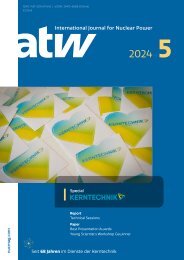Create successful ePaper yourself
Turn your PDF publications into a flip-book with our unique Google optimized e-Paper software.
<strong>atw</strong> Vol. 63 (<strong>2018</strong>) | Issue 8/9 ı August/September<br />
434<br />
INSIDE NUCLEAR WITH NUCNET<br />
A Stark Warning to Trump on China, Russia<br />
and the ‘Crisis’ Facing US Nuclear Industry<br />
NucNet, David Dalton<br />
The US has the largest number of nuclear plants in the world – 99 in commercial operation at the time of<br />
writing – but its global leadership position is said to be declining as efforts to build a new generation of<br />
reactors have been plagued by problems, and aging plants have been retired or closed in the face of economic,<br />
market, and financial pressures.<br />
A recent report by the Washington-based think-tank the<br />
Atlantic Council issued a stark warning, arguing that the<br />
US nuclear energy industry is facing a crisis that the Trump<br />
administration must immediately address as a core part of<br />
its “all of the above” energy strategy that is intended to<br />
herald an era of American energy dominance, with tens of<br />
billions of dollars to be spent on drilling and construction<br />
of pipelines, processing plants and liquefied natural gas<br />
export terminals. The administration might be bullish on<br />
energy policy, but the nuclear industry is worried.<br />
Six US nuclear plants have been shut down permanently<br />
since 2013 and 12 more are slated to retire over the<br />
next seven years. The Washington-based Nuclear Energy<br />
Institute, which represents the nuclear industry in the US,<br />
says the US electricity grid is enduring “unprecedented<br />
tumult and challenge” because of the loss of thousands<br />
and thousands of megawatts of carbon-free, fuel-secure<br />
generation that nuclear plants represent. Closing nuclear<br />
plants makes electricity prices go up and is putting<br />
emissions reduction targets hopelessly out of reach, NEI<br />
president and chief executive officer Maria Korsnick said.<br />
The Atlantic Council says the decline of the nuclear<br />
power industry in the US is “an important policy problem”<br />
that is not receiving the attention it deserves. The report<br />
was made public in the same week that Ohio-based utility<br />
FirstEnergy announced plans to permanently shut down<br />
its three nuclear power stations – Davis-Besse, Perry and<br />
Beaver Valley – within the next three years without some<br />
kind of state or federal relief.<br />
The nuclear industry has long argued that electricity<br />
markets should be reformed to recognise the ability of<br />
traditional baseload generation with onsite fuel supplies –<br />
including nuclear power plants – to provide grid resiliency<br />
during extreme events like hurricanes or extreme winter<br />
weather.<br />
To save financially-ailing nuclear plants, state legislatures<br />
in Illinois and New York last year approved subsidies to keep<br />
nuclear plants operating after utilities made appeals about<br />
protecting consumers and jobs. But other proposed bailouts<br />
of nuclear plants have stalled in New Jersey, Connecticut,<br />
Massachusetts, Ohio and Pennsylvania. In Minnesota, the<br />
state legislature is considering a bill that would help Xcel<br />
Energy, owner and operator of the Monticello and Prairie<br />
Island nuclear stations, plan for the high costs of maintaining<br />
old nuclear power plants. The proposed legislation would<br />
give utilities earlier notice about how much money they could<br />
recover for costly work, Minnesota Public Radio reported.<br />
The Atlantic Council report says nuclear power should be<br />
elevated in the Trump administration’s national security<br />
strategy because nuclear is an important strategic sector, and<br />
US global leadership and engagement in nuclear power are<br />
“vital to US national security and foreign-policy interests”.<br />
It also argues that nuclear power is an important<br />
component of a diversified US energy mix, but notes that in<br />
sharp contrast to developments in the US, China and Russia<br />
are pushing to expand their nuclear industries, develop<br />
complete fuel cycles, and build and commercialise new<br />
reactors for both domestic and international markets. The<br />
results of these efforts are striking – nearly two-thirds of the<br />
new reactors under construction worldwide are estimated to<br />
be using designs from China and Russia, countries that have<br />
the advantage of using “state- monopoly and authoritarian<br />
systems” to advance nuclear energy for geopolitical means.<br />
China has the largest nuclear construction programme<br />
in the world by far, with 20 of the 53 total reactors under<br />
construction worldwide. The 13 th Five-Year Plan (2016 to<br />
2020) calls for 58 GW of nuclear capacity online by<br />
2020 to 2021, and an additional 30 GW under construction<br />
at that time.<br />
But what is really worrying the US nuclear industry is<br />
the success of China’s nuclear strategy to establish joint<br />
ventures with Western companies (Toshiba-Westinghouse,<br />
Framatome-Areva, SNC-Lavalin, Energoatom) to build and<br />
evaluate different technologies (AP-1000, EPR, Candu,<br />
VVER-1000), and to incorporate this experience into its<br />
own indigenous designs. Although cost estimates are<br />
difficult to obtain, China has seemingly been able to build<br />
reactors quicker, and at lower cost, than the US, Europe,<br />
and even South Korea, the report says.<br />
China brings a complete package of design, construction,<br />
labour, technology, and financing, which improves<br />
the economics compared to industries in the West.<br />
Both China and Russia offer attractive financing<br />
packages to fund these projects. China goes into markets<br />
abroad with financing options from its Export-Import<br />
Bank, while Russia uses resources from both the Russian<br />
state budget and the Russia Wealth Fund.<br />
In contrast, says the NEI, the US Export-Import Bank’s<br />
board of directors remains without a quorum and as a<br />
result cannot consider medium- and long-term transactions<br />
exceeding $ 10 m. Typically, commercial nuclear<br />
deals are measured in billions of dollars, not millions:<br />
Turkish President Tayyip Erdoğan said that the investment<br />
in the country’s first nuclear power plant, being built by<br />
Russia’s Rosatom, will exceed $ 20 bn.<br />
While China’s relationship with nuclear power is<br />
relatively new – with its first nuclear plant completed in<br />
1991 – Russia’s long history with nuclear power dates to<br />
1954, when the first reactor was commissioned in Obninsk.<br />
The industry has since grown to 37 reactors in commercial<br />
operation and five under construction. Nuclear generation<br />
reached a record of 196.3 TWh in 2016, accounting<br />
for 17 % of domestic electricity generation, and further<br />
increased to 202.868 TWh and 19.9 % in 2017.<br />
Inside Nuclear with NucNet<br />
A Stark Warning to Trump on China, Russia and the ‘Crisis’ Facing US Nuclear Industry ı NucNet, David Dalton

















